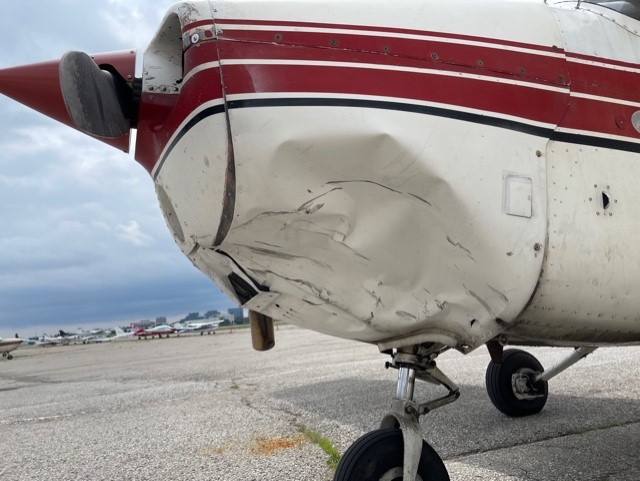Estimated reading time 4 minutes, 42 seconds.
A preliminary report has been released on the Aug. 10, 2021, incident where a Cessna 172N, operated by Canadian Flyers International, was struck by a drone while on final approach into Toronto Buttonville Municipal Airport (CYKZ).
On board the Cessna 172 were an instructor and a student who “had just turned from base leg to final for Runway 15” at CYKZ, according to the occurrence summary in the CADORS report (Transport Canada’s Civil Aviation Daily Occurrence Reporting System, which provides initial information on incidents with Canadian-registered aircraft).

The aircraft was stable at roughly 500 feet above ground level (AGL) when the student and instructor experienced a jolt that they assumed was a bird strike. Since they were about to land, there was no change in configuration or power; they proceeded with a normal landing. When they exited the aircraft, “they were shocked to see a major dent on the left underside of the engine cowling,” the report reads. The aircraft experienced a propeller strike, and the airbox was also bent. The drone was destroyed entirely.
While the aircraft suffered “major damage,” there were no injuries reported from the incident. The owner of the flight school told Toronto CityNews that the strike could have resulted in loss of life.
The drone, or remotely piloted aircraft system (RPAS), was operated by the York Regional Police for an operation in the Richmond Hill, Ontario, area. The drone was flying within one nautical mile of Buttonville airport when the strike occurred; the mid-air collision was identified in the CADORS report as unauthorized entry into controlled airspace.
The report states that air navigation service provider, Nav Canada, was not made aware of any RPAS operations in the area. In order to fly a drone in controlled airspace, Nav Canada must approve the operation, and radio contact must be maintained between the drone pilot and the controllers.

Aside from confirming that the drone was being utilized for a police operation, the York Regional Police has not commented any further on the collision, nor has the type of drone been identified.
This is the second time within 18 months that a police drone has collided with an aircraft in Canada. The other incident occurred in February 2020 with an RCMP-operated FLIR SkyRanger R60 surveillance drone and an RCMP Air Services AS350 B3 helicopter. The helicopter and drone were taking part in policing activities during protests in central British Columbia.
The RCMP confirmed that use of the metric system to measure the drone’s altitude was a contributing factor to the incident. The drone was flying at 355 feet (108 meters) AGL at the time of the collision, while the helicopter was also flying low (below 500 feet AGL).








